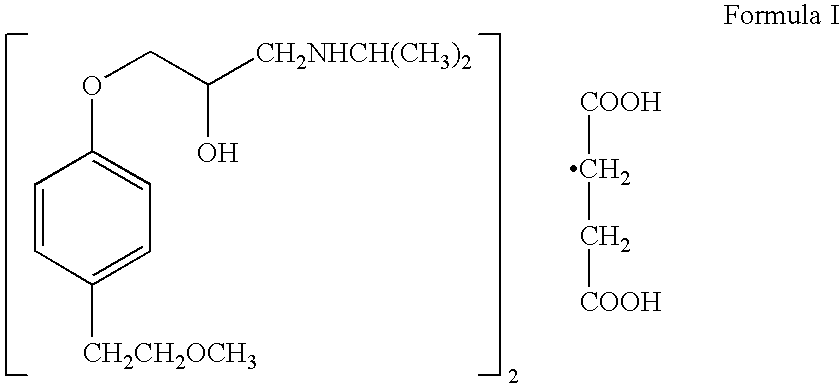Synthesis and preparations of metoprolol and its salts
- Summary
- Abstract
- Description
- Claims
- Application Information
AI Technical Summary
Benefits of technology
Problems solved by technology
Method used
Image
Examples
specific examples
[0045]The following examples are for illustrative purposes only and are not intended, nor should they be interpreted to, limit the scope of the invention.
[0046]General Experimental Conditions:
[0047]HPLC Method
[0048]The chromatographic separation was carried out in a Sperspher RP-select B (brand L7), 4 μm, 125×4.0 mm I.D. column at 30° C.
[0049]The mobile phase was prepared by mixing 400 mL of acetonitrile with 600 mL of sodium dodecyl sulphate solution, which was prepared by dissolving 1.3 g of sodium dodecyl sulfate in 1000 ml of aqueous phosphoric acid 0.1%. The mobile phase was mixed and filtered through 0.22 μm nylon membrane under vacuum.
[0050]The chromatograph was equipped with a 223 nm detector, and the flow rate was 0.9 mL per minute. Test samples (10 μL) were prepared by dissolving the appropriate amount of sample in the mobile phase in order to obtain 1 mg per mL of mobile phase.
Particle Size Analysis:
[0051]The particle size for metoprolol succinate was measured using a Mal...
example 1
Preparation of (±) 1-(isopropylamino)-3-[p-(2-methoxyethyl)phenoxy]-2-propanol succinate (2:1) (salt).
A. Preparation of 1,2-epoxy-3-(4-(2-methoxyethyl)phenoxy)propane
[0053]To a 400 L reactor containing 49.6 kg of deionized water was added 7.93 kg (0.125 kmol) of potassium hydroxide pellets (88.25%) while maintaining the temperature below 30° C. The mixture was stirred until dissolution and then 20 kg (0.131 kmol) of 4-(2-methoxyethyl)phenol was added. The reactor was then closed, inertized, and the mixture was stirred for 20 minutes. During which time an opaline solution was obtained.
[0054]To the above mixture, 12.54 kg (0.135 kmol) of R,S-epichlorhydrin was added over 30 minutes. The reaction mixture, which had two layers, was then heated to 35±2° C. and kept at this temperature for 6±1 hours. Thereafter, 0.41 kg (0.0064 kmol) of potassium hydroxide pellets (88.25%) and 0.38 kg of deionized water were added. The reaction mixture was then maintained at 35±2° C. for 15±1 hours. There...
example 2
Preparation of (±) 1-(isopropylamino)-3-[p-(2-methoxyethyl)phenoxy]-2-propanol succinate (2:1) (salt).
[0064]This example was performed using the same quantities and conditions described in Example 1. The particle size distribution for this example is as follows:
[0065]Before milling: D (v, 0.1): below 6.9 μm, D (v, 0.5): below 22.8 μm, and D (v, 0.9): below 52.4 μm.
[0066]After milling: D (v, 0.1): below 4.9 μm, D (v, 0.5): below 18.0 μm, and D (v, 0.9): below 48.6 μm.
PUM
| Property | Measurement | Unit |
|---|---|---|
| Temperature | aaaaa | aaaaa |
| Temperature | aaaaa | aaaaa |
| Temperature | aaaaa | aaaaa |
Abstract
Description
Claims
Application Information
 Login to View More
Login to View More - R&D
- Intellectual Property
- Life Sciences
- Materials
- Tech Scout
- Unparalleled Data Quality
- Higher Quality Content
- 60% Fewer Hallucinations
Browse by: Latest US Patents, China's latest patents, Technical Efficacy Thesaurus, Application Domain, Technology Topic, Popular Technical Reports.
© 2025 PatSnap. All rights reserved.Legal|Privacy policy|Modern Slavery Act Transparency Statement|Sitemap|About US| Contact US: help@patsnap.com



